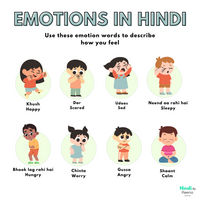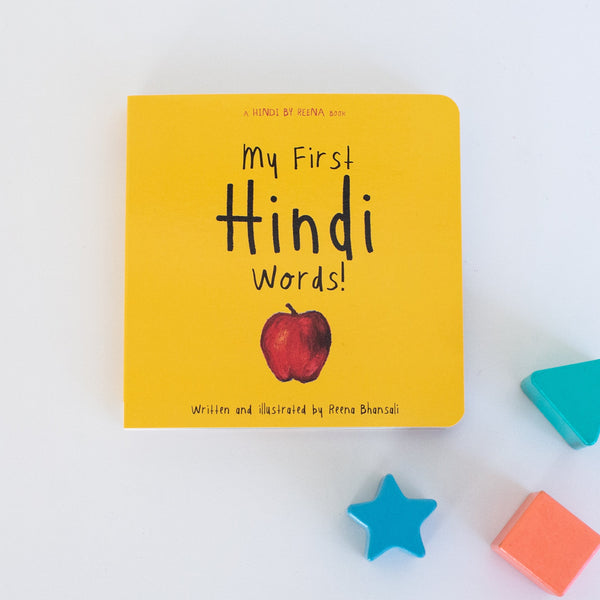Teaching Your Child Hindi? Do Yourself a Favor — Ditch the Hindi Script (for now)
Most people who start teaching their child Hindi, teach script first and the actual language second.
This is a BIG mistake which can lead to many different issues down the line.
For one, Devanagari is extremely different from the English script. It can be confusing and intimidating for your child (this is especially the case if they don’t know how to speak or understand it yet).
This confusion can lead to embarrassment, and general disliking of Hindi, which makes them want to use it less.
Just to illustrate the point, read the below poem.
Regardez les branches
Comme elles sont blanches,
Il neige des fleurs.
Riant de la pluie
Le soleil essuie
les saules en pleurs.
Unless you speak French, the poem extract means nothing to you. You could probably sound out the letters and read it out loud – but in reality, it is just jibberish.
This is what it is like if your kids do not understand or speak Hindi, but are taught the alphabet first. They can read the alphabet. Use the matras. But it means nothing if they cannot answer “aapka naam kya hai.”
As an Indian who grew up in the US, my siblings and I started learning Hindi through conversation. We would talk to my grandmother in Hindi, watch movies, and learn new words by asking questions and actively using them. I only learnt the alphabet when I was older, when I understood a good chunk of what I was reading and writing.
When I started teaching – with other Hindi teaching schools – they believed the alphabet was king. I would say “Ka” and the class would drolly repeat after me and I would provide some associated words like “kabutar” and “kachua.”
Within a few months, about 60% of those students either 1) lost interest in learning the language or 2) continued to learn, but hated it. Essentially, they had given up — and they hadn’t even learnt anything of value yet.
If you want to teach your kid Hindi – your success rate will be guaranteed to go up if you teach Devanagari LAST. Why?
1. It’s the least important aspect of learning the language
While learning Hindi script is important, it is actually just a tool to express a language you already know. That’s why your child needs to actually learn that language first, then focus on reading and writing.
2. Wastes Time
If you are like most parents, you don’t have much time in your day that isn’t filled with driving your kids around, doing homework, and eating. If you are going to commit yourself to teaching and encouraging your child in Hindi – go straight for the meat and get them to start USING the language ASAP.
You don’t know how long Hindi will keep your kid’s interest, so you might as well get the real Hindi (conversation, words, sentence structure, answers, etc.) out of the way first.
3. Kids lose interest
Tracing a letter over and over is probably the least engaging activity a child can do. It is especially boring if they have no idea how the letter is used every day. Once your child finds soccer, dance or any other more engaging activity, Hindi will happily fall to the bottom or even fall off their list of to-dos completely.
4. Little to no real world rewards
Living outside India, kids rarely see Hindi script written on signs or on posters. And without being able to see Hindi script in real life, they won’t be able to see their efforts pay off. Unlike kids in India, kids living overseas can’t look at the writing on a truck and say “hey! I know that word – it says “Laloo ki gaddi!” Without this luxury, the barriers between them and Devanagari , and therefore Hindi, just increases.
5. They can’t show off
Unless you carry around a chalkboard, your child cannot show off their Devanagari at the next family wedding. Sadly, your child will miss out on some very valuable positive reinforcement that would otherwise fuel them to keep learning.
Instead, imagine your kid spent all that “alphabet-memorizing-time” on learning words and phrases and conversation. They could talk to relatives, get positive reinforcement and keep learning by talking.
6. Letters don’t extend the learning
Once you learn the alphabet, that’s it, you’re done. You could learn a few vocab words like “khargosh” or “kitaab” but it would stop there.
On the other hand, a child can learn a phrase — and actually use it at a party or at a Indian restaurant. With each phrase, they would get two totally different answers that will teach them even more of the language.
What is the solution?
Forget the tools/ the alphabet (for now) – go straight to the core!
We need kids to believe that Hindi is a real language that can be used in everyday situations. It can’t just be hard letters. It needs to come alive on TV, on the radio, through music, through dance and most important of all through conversation.
Don’t get me wrong, Devanagari is important to learn…LAST. Let your kids know what they are saying before they know how to read and write it.
WHAT SHOULD REPLACE DEVANAGARI?
1. Teach your child how to introduce themselves
2. Teach them 5 nouns that you think are important – maybe kitaab, gaadi, joota, darvaza, kapRe.
3. Go to my section on Actions and teach them useful verbs
4. Watch Hindi movies or TV shows and explain some key words
5. Find language worksheets and materials that work for you (I have a Freemium Membership where you can find worksheets, learning videos and games).







